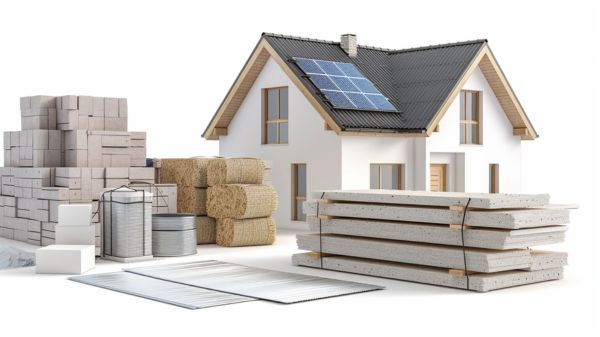10 Best Insulation Materials for Energy-Saving Homes
You might be surprised to learn that the choice of insulation materials can have a significant impact for building energy-saving homes. With a plethora of options available, ranging from spray foam to cellulose and beyond, the decision can be overwhelming.
However, understanding the unique advantages of each material can help you make informed choices for your home’s insulation needs. By exploring the top ten insulation materials for energy-saving homes, you can discover which options align best with your priorities, whether it’s thermal performance, sustainability, or cost-effectiveness.
Key Takeaways
- Spray foam insulation provides high R-value and air-tight sealing for energy efficiency.
- Cellulose insulation offers eco-friendly solutions with recycled material for sustainable homes.
- Rockwool insulation stands out with exceptional fire resistance and versatility for various applications.
- Fiberglass insulation is a cost-effective choice with easy installation for energy-saving benefits.
Spray Foam Insulation
When considering insulation materials for energy-efficient homes, spray foam insulation stands out for its superior thermal resistance and air-tight sealing properties. With an impressive R-value ranging from 6 to 7 per inch, spray foam effectively minimizes heat transfer, enhancing energy efficiency.
This type of foam acts as a robust air barrier, reducing air infiltration and preventing energy loss in buildings. Spray foam’s unique ability to expand upon application allows it to fill gaps, cracks, and voids seamlessly, providing comprehensive coverage and maximizing insulation effectiveness.
Whether you choose closed-cell for its high density and water resistance, or open-cell for its cost-effectiveness and sound-dampening qualities, spray foam insulation proves to be a versatile and efficient option for creating well-insulated and energy-saving homes.
Fiberglass Insulation
Fiberglass insulation offers a cost-effective solution for insulating your home while providing excellent thermal performance. Its ease of installation makes it a practical choice for homeowners looking to enhance energy efficiency.
With an R-value between 2.9 and 3.8, fiberglass insulation effectively reduces heat loss, making it a popular option for many households.
Cost-Effective Insulation Solution
How does fiberglass insulation offer a cost-effective solution for enhancing energy efficiency in homes?
Fiberglass insulation stands out as a cost-effective option due to its favorable R-value, typically ranging from 2.9 to 3.8. This value signifies its ability to resist heat flow efficiently, reducing the need for constant heating or cooling.
Additionally, fiberglass insulation’s durability and resistance to water absorption and mold growth contribute to its cost-effectiveness by requiring minimal maintenance over time. Its non-combustible nature adds a layer of safety to the home, making it a reliable choice for insulation.
Being easy to install as blankets or batts, fiberglass insulation further enhances its cost-effectiveness, making it a practical and affordable solution for improving energy efficiency in residential spaces.
Easy to Install
With its user-friendly installation process and versatile forms, fiberglass insulation emerges as a practical choice for enhancing energy efficiency in residential structures. DIY-friendly fiberglass insulation offers simplicity and cost-effectiveness, making it a popular option for homeowners. Available in blanket form or as loose-fill material, it caters to various insulation needs.
Fiberglass insulation boasts a thermal resistance, with an R-value ranging from 2.9 to 3.8, providing decent insulation properties. Additionally, this type of insulation doesn’t wick water or catch fire easily, ensuring safety in homes. Homeowners looking to improve energy efficiency can rely on fiberglass insulation for an easy-to-install solution that offers both thermal performance and convenience.
Excellent Thermal Performance
Enhancing the thermal efficiency of your home, fiberglass insulation stands out for its exceptional performance in maintaining consistent indoor temperatures and reducing energy loss. Here’s why it’s an excellent choice for energy-saving homes:
- High R-values: Fiberglass insulation offers R-values ranging from 2.9 to 3.8, providing effective thermal resistance.
- Safety and Efficiency: This insulation type is non-wicking and fire-resistant, ensuring a safe and efficient solution for your home.
- Eco-Friendly Production: Made from recycled materials like glass, soda ash, and limestone, fiberglass insulation boasts eco-friendly characteristics while delivering top-notch thermal performance.
Cellulose Insulation
Cellulose insulation offers an eco-friendly option for homeowners seeking sustainable solutions. Its high R-value, ranging from 3.1 to 3.7, ensures efficient thermal resistance, contributing to substantial energy savings.
The installation process and cost-effectiveness of cellulose insulation make it a practical choice for comprehensive coverage in hard-to-reach spaces.
Eco-Friendly Cellulose Option
Utilizing recycled paper products, cellulose insulation emerges as a sustainable and eco-friendly choice for enhancing home energy efficiency. This option not only supports environmental sustainability but also provides excellent thermal resistance with an R-value ranging from 3.1 to 3.7.
Here are three compelling reasons to consider cellulose insulation for your home:
- Environmental Impact: By opting for cellulose insulation, you actively participate in sustainable practices by utilizing recycled materials, reducing waste, and promoting a greener future.
- Efficient Coverage: The ability of cellulose insulation to be blown into small spaces ensures comprehensive coverage, minimizes air leakage, and maximizes energy efficiency.
- Safety Enhancement: Beyond energy savings, cellulose insulation is renowned for its fire-retardant properties, enhancing safety measures within your living space.
Installation Process and Cost
How does the cost-effective installation process of cellulose insulation compare to other energy-saving options? When considering the installation process and cost, cellulose insulation stands out as a budget-friendly and efficient choice.
The installation of cellulose insulation involves blowing the material into small spaces, ensuring a tight seal that minimizes heat transfer. This method is particularly effective at creating a well-insulated home while being environmentally friendly.
Below is a comparison table showcasing the installation cost of cellulose insulation against other common energy-saving options:
| Insulation Material | Installation Process | Cost |
|---|---|---|
| Cellulose Insulation | Blown into small spaces | $1.00/sq.ft |
| Fiberglass Insulation | Cutting and fitting | $1.20/sq.ft |
| Spray Foam Insulation | Spraying and expanding | $2.00/sq.ft |
Mineral Wool Insulation
Mineral wool insulation stands out as an environmentally-friendly and fireproof solution for homes, offering exceptional safety and thermal efficiency. Here are three reasons why mineral wool insulation is an excellent choice for energy-efficient homes:
- Eco-Friendly Composition: Mineral wool insulation is typically made from natural elements or steel mill waste, with around 75% of its content being recycled materials, making it a sustainable option.
- Fireproof Properties: This type of insulation provides added safety and protection due to its fire-resistant nature, ensuring a secure environment for your home.
- Effective Thermal Resistance: With an R-value ranging from 2.8 to 3.5, mineral wool insulation delivers superior thermal performance, helping to reduce energy consumption and costs.
Polyurethane Insulation
Polyurethane insulation, recognized for its exceptional thermal resistance with an R-value ranging between 3.8 and 6.3, is widely utilized for its energy-saving capabilities in various residential and commercial applications.
This type of insulation, often applied using a spray foam method, effectively fills small cracks and air spaces, providing a high R-value and creating a tight air seal.
While polyurethane insulation may come at a higher cost than fiberglass or cellulose, its superior energy-saving benefits make it a popular choice for those seeking to enhance energy efficiency in buildings.
By preventing heat loss during winter and heat gain in summer, polyurethane insulation significantly contributes to reducing energy consumption and lowering utility bills.
| Pros | Cons |
|---|---|
| High R-value | Higher cost |
| Effective air seal | Installation complexity |
| Energy-saving benefits | Limited DIY application |
Polystyrene Insulation
Polystyrene insulation, available in expanded (EPS) and extruded (XEPS) forms with respective R-values of 4 and 5.5, is widely utilized for its efficient thermal performance in various construction projects.
Here are three reasons why Polystyrene insulation stands out:
- Cost-Effective: Polystyrene insulation is known for its affordability, making it an attractive option for budget-conscious projects.
- Versatile Application: Its rigid sheets or blocks can be easily fitted into walls, offering flexibility in installation for different construction needs.
- High Thermal Performance: With R-values of 4 and 5.5 for EPS and XEPS respectively, Polystyrene insulation provides excellent thermal resistance, ensuring energy efficiency in buildings.
Rockwool Insulation
Rockwool insulation is known for its exceptional fire-resistant properties and flexibility during installation. It is a reliable choice for homeowners seeking long-lasting insulation solutions due to its durability and resistance to moisture. The impressive R-value of up to R-3.3 per inch ensures efficient thermal performance, contributing to energy savings in your home.
This insulation material offers great peace of mind to homeowners who prioritize safety and energy efficiency in their living spaces.
Fire-Resistant Properties
Extruded from lava rock, rockwool insulation boasts exceptional fire resistance properties, making it a preferred choice for structures prioritizing fire safety. Here’s why rockwool insulation stands out in terms of fire-resistant properties:
- Non-Combustible Nature: Rockwool is inherently non-combustible, ensuring that it doesn’t contribute to the spread of fires.
- High Temperature Tolerance: With the ability to withstand high temperatures, rockwool provides a reliable barrier against flames and heat.
- Fire Safety Priority: Commonly used in areas where fire safety is paramount, such as commercial buildings and industrial settings, rockwool insulation offers peace of mind when it comes to thermal protection and fire resistance.
Rockwool’s impressive fire-resistant qualities make it a sound choice for those seeking both energy efficiency and safety in their homes or buildings.
Installation Flexibility
Given the exceptional fire-resistant properties of rockwool insulation, its installation flexibility becomes a crucial aspect to consider for optimizing energy efficiency in various areas of a building or home.
Rockwool insulation’s versatile nature allows for easy installation in walls, attics, floors, and ceilings, adapting to different architectural designs seamlessly.
With an impressive R-value of up to R-3.3 per inch, rockwool ensures high thermal performance, reducing heat transfer and energy consumption effectively.
Its ability to withstand moisture and fire makes it a durable choice for long-term energy savings.
Whether retrofitting an existing home or constructing a new one, rockwool insulation offers the flexibility needed to enhance insulation and create a more energy-efficient living space.
Loose-Fill Insulation
When considering insulation options for energy-efficient homes, loose-fill insulation made of materials like fiberglass, cellulose, or mineral wool stands out for its effectiveness in filling gaps and irregular spaces. This type of insulation is installed by blowing or pouring the loose material into wall cavities, attics, or other enclosed spaces.
Here are three reasons why loose-fill insulation can be a great choice for your home:
- Conforms to Various Shapes: Loose-fill insulation has the ability to conform to different shapes and sizes within a structure, ensuring comprehensive coverage.
- Enhanced Thermal Performance: Loose-fill insulation is known for its ability to provide better thermal performance by filling gaps and irregular spaces effectively.
- Cost-Effective Energy Efficiency: It offers consistent coverage and can be a cost-effective option for improving energy efficiency in homes.
Eco-Friendly Insulation Options
For environments prioritizing sustainability, exploring eco-friendly insulation options becomes essential in reducing carbon footprint and promoting sustainable building practices.
Eco-friendly choices like recycled denim, cellulose, sheep wool, and cork offer environmentally conscious alternatives to traditional insulation materials. These options align with eco-friendly wood-frame construction projects that aim to minimize environmental impact.
While materials like polystyrene and Aerogel are man-made alternatives available for sustainability-focused construction, recycled denim and cellulose stand out as eco-friendly options for energy-efficient homes.
Despite potentially higher costs, choosing these insulation materials can significantly contribute to reducing carbon footprint and advancing sustainable building practices, making them ideal for those seeking to create energy-saving homes with minimal environmental impact.
Reflective Insulation Systems
Exploring the realm of energy-efficient insulation further, reflective insulation systems present a notable solution for reducing heat transfer and enhancing energy efficiency in homes. Here are three reasons why you should consider reflective insulation for your energy-saving needs:
- Reflective insulation effectively reduces radiant heat transfer, aiding in maintaining comfortable indoor temperatures.
- In hot climates, these systems can reflect up to 97% of radiant heat, leading to significant reductions in cooling costs.
- By installing reflective insulation in attics, walls, and roofs, you can contribute to overall energy savings in your home while ensuring a more sustainable living environment.
Consider the benefits of reflective insulation for improved energy efficiency and long-term cost savings.
Frequently Asked Questions
What Is the Most Energy-Efficient Home Insulation?
For the most energy-efficient home insulation, opt for spray foam. It seals tight, cutting costs up to 30% compared to other types. Its high R-value and durability ensure optimal thermal performance year-round, making it a wise investment.
Which Is the Most Efficient Insulating Material?
When evaluating insulation materials, consider thermal conductivity comparisons, insulation cost analyses, and insulation effectiveness evaluations. Spray foam insulation boasts the highest efficiency due to its superior R-value, airtight sealing, and potential for significant energy savings.
Which Material Is Better for Insulating a House?
When insulating your home, consider cost-effective options like fiberglass for DIY installation or spray foam for weatherproof solutions. Evaluate R-values and installation ease to determine the best material for your needs.
What Is the Most Eco Friendly Insulation Material?
When considering eco-friendly insulation materials, focus on sustainable options like sheep’s wool, recycled denim, cork, cellulose, and aerogel. These green building materials are eco-conscious choices that promote sustainability and energy efficiency in your home.
Conclusion
When considering the insulation materials for energy-efficient homes, it’s essential to weigh the benefits of each option in terms of R-value, fire resistance, moisture protection, and cost-effectiveness.
By selecting the most suitable insulation materials for different areas of your home, you can effectively enhance comfort, lower energy costs, and minimize your environmental impact.
Making informed choices about insulation is key to creating a sustainable and energy-saving living space.







One Comment
Comments are closed.